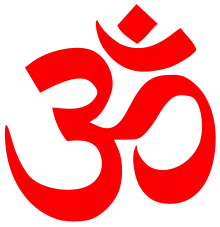 | |
| Total population | |
|---|---|
| 250,000 (2020) | |
| Regions with significant populations | |
| Religions | |
| Hinduism | |
| Scriptures | |
| Vedas · Puranas · Upanishads · Ramayana (incl. Ramcharitmanas version) · Mahabharata (incl. Bhagavad Gita) · other Hindu texts | |
| Languages | |
| Sanskrit · Tamil (liturgical languages) Guyanese English Creole · English · Guyanese Hindustani | |
| Related ethnic groups | |
| Trinidadian and Tobagonian Hindus · Surinamese Hindus · Jamaican Hindus · other Caribbean Hindus |
| Hinduism by country |
|---|
  |
| Full list |
Hinduism is the religion of about 31% of the population of Guyana in 2020.[1][2] This makes Guyana the country with the highest percentage of Hindu residents in the Western Hemisphere.[3]
History
After the 1833 Slavery Abolition Act in the British Empire, the need for labour led to the recruitment of Indians in Guyana and other British West Indian territories. Upon arrival, the new workers had to adapt to the extreme tropical conditions, along with their new contracts and working conditions. Between 1835 and 1918, 341,600 indentured labourers were imported into British Guyana from India.[4]
From 1852, Christian missionaries attempted to convert East Indians during the indentured servitude period, but this was met with little success. In response to Christian proselytizing, Brahmins began administering spiritual rites to all Hindus regardless of caste.
In the late 1940s, reform movements caught the attention of many Guyanese Hindus. In 1910, Arya Samaj arrived in Guyana. Samaj's doctrine rejects the idea of caste and the exclusive role of Brahmins as religious leaders. The movement preaches monotheism and opposition to the use of images in worship as well as many traditional Hindu rituals.
Demographics
Hinduism had been slowly decreasing for many decades. In 1991, 35.0% of the Guyanese population adhered to Hinduism, decreasing to 28.4% in 2002,[5] 24.8% in 2012[6] but increasing to 31.0% in 2020.[1]
| Year | Percent | Decrease |
|---|---|---|
| 1980 | 35.7% | - |
| 1991 | 35.0% | -0.7% |
| 2002 | 28.4% | -6.6% |
| 2012 | 24.8% | -3.6% |
| 2020 | 31.0% | +6.2% |
Geographical distribution of Hindus
| Region | Percent of Hindus (2002) | Percent of Hindus (2012) |
|---|---|---|
| Barima-Waini | 8.1% | |
| Pomeroon-Supenaam | 37.3% | |
| Essequibo Islands-West Demerara | 46.5% | |
| Demerara-Mahaica | 24.4% | |
| Mahaica-Berbice | 39.0% | |
| East Berbice-Corentyne | 46.4% | |
| Cuyuni-Mazaruni | 5.6% | |
| Potaro-Siparuni | 6.4% | |
| Upper Takutu-Upper Essequibo | 0.5% | |
| Upper Demerara-Berbice | 4.7% | |
| Guyana | 28.4% |
Tamil (Madrasi) Hindus forms the majority in East Berbice-Corentyne region and practice Caribbean Shaktism.[7]
According to the 2012 census, 39.8% of the Guyana's population is of East Indian origin and 24.8% are Hindus.[6] The remainder is mostly Muslim (6.8%) or Christian (62.7%).
Public Holidays
Holi-Phagwah and Deepavali are National Holidays in Guyana.[8]
Temples

- Tain Hindu Mandir
- Central Vaidik Mandir
- Sita Ram Toolsie Vade Ganesh Mandir
- Shree Maha Kali Devi Temple
- Edinburgh Shree Krishna Mandir
- Hampton Court Mandir
- D'Edward Vighneshwar Mandir
See also
References
- 1 2 World Religion Database at the ARDA database, retrieved 2023-08-08
- ↑ "Religions in Guyana". globalreligiousfutures.org. Retrieved 10 February 2022.
- ↑ "Percent Hindu – country rankings". the Global Economy. Retrieved 5 November 2018.
- ↑ Despres, Leo, "Differential Adaptions and Micro-Cultural Evolution in Guyana," Southwestern Journal of Anthropology, 25:1, 22.
- ↑ "Chapter Ii" (PDF). Retrieved 3 November 2018.
- 1 2 "Organization" (PDF). www.state.gov. Archived from the original (PDF) on 15 August 2017.
- ↑ Stephanides, Stephanos; Singh, Karna Bahadur (3 November 2018). Translating Kali's Feast: The Goddess in Indo-Caribbean Ritual and Fiction. Rodopi. ISBN 978-9042013711 – via Google Books.
- ↑ "Guyana".